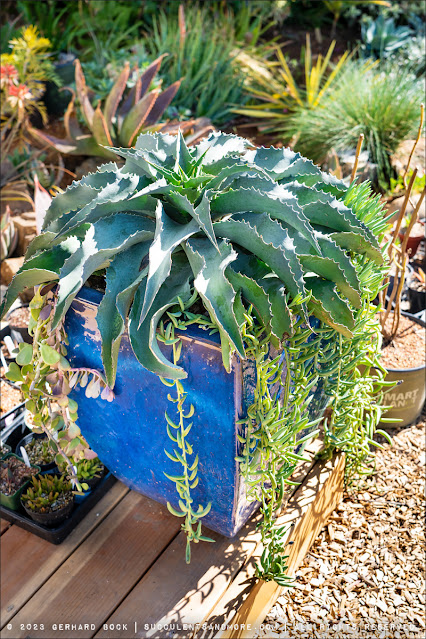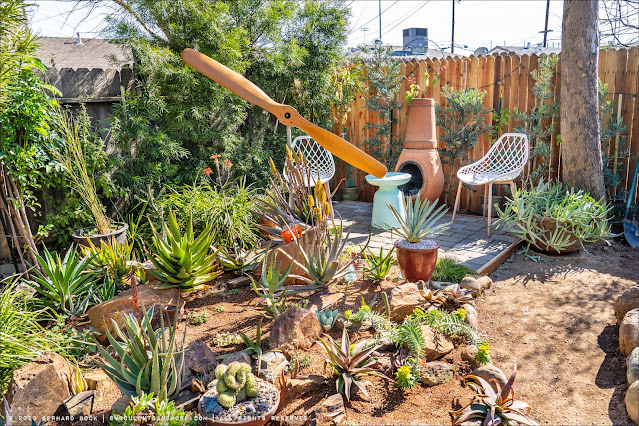More rocks, more plants: update on geologist Kyle's garden
I haven’t known my friend Kyle all that long, but I’ve already blogged twice about his garden in Sacramento: “A geologist’s garden: succulents and rocks” (July 2022) and “Collecting rocks and succulents: Kyle’s garden in Sacramento” (December 2022). Three months on, it’s time for another update.
As you’ll see, Kyle hasn’t been sitting still. In fact, he’s gotten more done than most people would in a year. And what he’s accomplished is seriously inspiring.
In late November 2022, his front yard looked like this:
 |
| Kyle’s front yard on November 25, 2022 |
Now it looks like this:
Kyle removed the existing plants and built up the area with extra soil and lava fines. He then added rocks sourced from the Gold Country, primarily slate, to add visual interest and to create pockets for smaller plants. The result is spectacular.
Take a closer look at the vignettes below. Each one is a standout in its own way.
Small cacti and others succulents that might otherwise get lost in are given their own stage to shine. Seeing how many grow among rocks in the wild, Kyle has essentially created an approximation of their natural habitat.
The backyard, which had looked pretty much finished to me last November, underwent a number of changes as well. This ranged from relocating plants and overhauling smaller areas to taking out large shrubs (several oleanders) and planting new screening plants (four Podocarpus ‘Glacier Blue’) to even moving a patio. Kyle has the vision, drive, and energy to make major things happen in record time.
 |
| Kyle added a few columnar cacti in this bed |
 |
| I still think these core samples are über cool |
 |
| Dudleya hassei ssp. virens thriving among the rocks |
 |
| Lewisia cotyledon, a succulent from the mountains of far northern California |
 |
| The royal blue ceramic ornament is actually a lotus flower, but it matches the Agave victoriae-reginae on the left perfectly |
 |
| Speaking of blue, look at this stunning specimen of Agave utahensis var. nevadensis. It needs sharp drainage to survive wet winters, and that’s exactly what Kyle has created here. |
The bed you see in the next set of photos is new:
Larger aloes, cacti, and other succulents are planted towards the back, leaving space in the front for jewel-like miniatures nestled against the rocks:
A few potted plants that caught my eye:
 |
| Euphorbia canariensis staged with a nautilus shell and red quartz crystals from Morocco |
 | |
|
A couple of wider shots across the backyard:
After removing several large oleanders and planting a row of Podocarpus ‘Glacier Blue’, Kyle relocated the small patio you see in the next photo closer to the fence:
 |
| The propeller is from a neighbor who posted it on a local Facebook group. Kyle saw its potential and built a stand for it. And yes, it moves. |
A particularly nice aloe combo:
 |
| Aloe ‘Tangerine’ (back), Aloe ‘Safari Sunrise’ (front) |
Two cool rocks from Kyle’s collection (remember he’s a geologist by profession) that haven’t made it into the garden yet:
 |
| Left: black tourmaline (collected by Kyle in San Diego County). Right: chalcocite, covelite and malachite (all copper minerals) in limestone host rock (from Kennecott Mine, McCarthy, Alaska) |
Last Saturday, Kyle and I drove to the Gold Country to pick up more rocks, and when I left his house at 1 pm, the front yard looked like this:
I went home, unloaded my rocks, and then took a nap. Kyle, on the other hand, went right to work.
Here’s the new pile of rocks in Kyle’s truck (all the photos below are by Kyle):
First he unloaded the rocks from his truck and piled them on the lawn. Then he removed the plants from this corner of the front yard and graded the soil:
Next he picked up a load of lava fines from a local rock yard and dumped it onto the soil to build up the area:
Here’s the finished result later that evening:
Kyle doesn’t twiddle his thumbs. He decides what needs to be done—and then gets it done. I want to be more like Kyle.
In a future post, I’ll show you a number of before, during, and after photos of Kyle’s garden that he’s shared with me. They’ll illustrate Kyle’s landscaping approach: building mounds on top of the existing soil, adding rocks, and planting succulents in a naturalistic way to ensure perfect drainage and create visual appeal.
RELATED POSTS:
- A geologist’s garden: succulents and rocks (July 2022)
- Collecting rocks and succulents: Kyle’s garden in Sacramento (December 2022).
© Gerhard Bock, 2023. All rights reserved. To receive all new posts by email, please subscribe here.
























Great inspiration for transitioning toward low water landscaping—beautiful.
ReplyDeleteAgreed!!! Kyle has an instinctive sense of what looks good.
DeleteAnother wonderful find. I especially love the natural feeling stone work.
DeleteI've read this through, and was so impressed by his choice of rocks I couldn't even look at the plants. I'm going to immediately reread the whole thing! The last reveal is so beautiful, the colors & textures are wonderful.
ReplyDeleteI'm so glad that you enjoyed this post. You can never have enough rocks.
DeleteOMG - Kyle certainly isn't a slacker! In addition to being in awe of what he's accomplished, I loved the small decorative touches like the ceramic lotus and the nautilus shell, both which accent his succulent displays without overshadowing them. I'd never heard of lava fines and now I'm wondering where I can get some when I finally get around to a wholesale renovation of the succulent bed in front of our garage. As I don't have the same level of energy as Kyle, all I can say is that'll be sometime this year.
ReplyDeleteLava fines are just extra small pieces of lava rock, typically 3/8", sometimes even smaller. It's the stuff that is left at the bottom of a pile of larger lava rocks. Many rock yards (at least around here) carry it. They may simply call it 3/8" lava rock. It's a great way to improve drainage. I also use 3/8" lava as top dressing.
DeleteKyle had cool plants, super cool rocks, an extraordinary vision and an eye for design. He also seem to have energy in abundance... a must when one deals with hard labour. I'd be taking a nap too...
ReplyDeleteAfter seeing this post, I'm going to excavate and elevate my Lewisia, and find some nice rocks to highlight it.
I love both pots you showed here. Aloe ‘Tangerine’ and ‘Safari Sunrise’ create an inspired vignette!
Chavli
Energy – yeah, Kyle has tons of it. Way more than I do!
DeleteLewisias naturally grow on rocks. They look great elevated.
Totally agree about the rocks, it adds such interest, and compliments the plants so well. I've been a little obsessed about the right kind of rocks for a while. Here in England, I have a friend who has unearthed some beautiful quartz rocks in Wales wherehe now lives, of which will be in my drybed as soon as spring finally arrives. Ps beautiful garden. Wayne
ReplyDeleteWhen we originally built our garden I didn't pay much attention to rocks. Now I wish I had. But I've been adding some rocks over the years.
DeleteQuartz from Wales, that's got to be spectacular!!
Oh to be young and have so much energy. Kyle's garden looks fabulous.
ReplyDelete